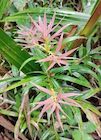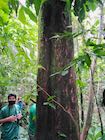Podocarpus guatemalensis
Standl. 1924
Common names
Ocotillo de llano [Spanish].
Taxonomic notes
Type: Guatemala, Dept. Izabal, vicinity of Puerto Barrios, sea level, 1922.06, P.C. Standley 25090 (holo US, iso GH). It is interesting to read Standley's account (1924); this was the first discovery of a low-elevation tropical podocarp, and he found it mystifying. Synonymy (Farjon 1998, Mill 2015):
- Podocarpus pinetorum Bartlett 1935;
- Podocarpus allenii Standl. 1941;
- Podocarpus guatemalensis Standl. var. pinetorum (Bartlett) J. Buchholz et N.E. Gray 1948;
- Podocarpus guatemalensis Standl. var. allenii (Standl.) J. Buchholz et N.E. Gray 1948;
- Podocarpus guatemalensis Standl. subsp. allenii (Standl.) Silba 2010;
- Podocarpus guatemalensis subsp. pinetorum (Bartlett) Silba 2010.
Mill (2015, pp. 248-249) provides a detailed review of prior authors' views on the infraspecific taxa, and reduces them to synonymy. Later, on page 269 he says that he accepts the varieties, but he provides no cues on how they differ in morphology. It seems the varietal names have been geographically applied, with var. guatemalensis applied to plants from Guatemala, var. pinetorum for plants from Belize, and var. allenii for plants from Costa Rica and Panama.
Description
Dioecious trees to 45 m tall and 70 cm dbh, with a pyramidal to spreading (sometimes dense and compact)
crown. Bark rough, flaky, gray- or reddish-brown, inner bark red-brown. Current-year twigs green, in pairs or whorls of 3, diverging at 45–70°, straight or flexuous, 3–15 cm long, 1.4–2.3 mm thick. Terminal buds ovoid-globose, 1.8–4 × 1.1–4.1 mm, the base wider than or equalling width of twig, with 8–20 ovate or ovate-rhombic scales that are caducous or persistent, 0.9–3.3 × 0.4–2.3 mm, keeled, tips erect, apex obtuse to aristate, margins entire, hyaline. Flushing leaves in bunches of 11-23, reddish-green, not glaucous; leaves last 1 or 2 years. Leaves on twisted 2.2-4.5 mm petiole, diverging at 47–62°, coriaceous but pliable, spreading horizontally and slightly drooping, deep to medium green and glossy above, pale green and matte below, narrow, elliptic to lanceolate, normally broadest at or below middle but sometimes obovate on mature trees. Leaves on mature trees 30–70 × 8–14 mm and 4–7 times as long as broad, mostly straight or slightly falcate; juvenile and shade leaves much larger, 100–115 × 11–13 mm, 8–10 times as long as broad, strongly falcate. Leaves have a slightly thickened but not revolute margin; midrib continuously and slightly raised on upper (adaxial) surface, but not raised on lower surface; apex variable but on mature foliage usually long-acuminate. Pollen cones borne along central or distal portion of previous season’s growth in groups of 4–8 buds that are ovoid, 1.6–2.6) × 1.1–2.2 mm, 1–5 mm apart. Basal scales dark chestnut-brown, suberect, ovate, 0.9–1.4 × 0.7–1 mm, obtuse, muticous, with entire margins. Individual pollen cones single, sessile or on pedicels to 1 mm long, cream or greenish yellow, cylindrical, 14–45 &time;s 2–3.3 mm. Pollen white. Seed cones 1 or occasionally 2 per peduncle, borne on current growth, peduncles 1.2–3.5 mm (shorter on some Belize plants), basal scales absent. Receptacle subglobose, infundibular or cylindrical, 4.5–6.5 mm along long edge, violet-purple in receptive stage turning green in resting phase and ripening through yellow to finally red, the bracts connate and fused. Seeds 1 per receptacle, ellipsoid or ovoid, 5.2–6.8 × 4.1–5.5 mm, greenish, with a very low and blunt crest, 0.2–0.4 × 0.4–1 mm. Phenology not well known but active pollen cones coincide with local dry seasons, which vary in timing through the species' range from Oaxaca to Panama (Mill 2015).
Podocarpus guatemalensis is distinct from all other Central American Podocarpus in having globose terminal vegetative buds and leaves with a raised upper midrib (Mill 2015).
Distribution and Ecology
Belize; Colombia; Costa Rica; El Salvador (doubtful); Guatemala: Dept. Izabal; Honduras; Mexico: Oaxaca and Veracruz; Nicaragua; Panama; possibly Venezuela (Farjon 1998, Mill 2015). See Mill (2015) for details; in his work he reassigned many putative specimens of P. guatemalensis to other Podocarpus species, mostly P. matudae, with resulting adjustments in the range mapping.
The species occurs at elevations of 0-1000 m on deep brown soils and siliceous soils derived from granite and volcanics. In the Sierra de las Minas of Guatemala, P. guatemalensis grows on serpentines. Habitats include humid and perhumid forest, broadleaved riparian forest, cloud forest, montane forest and elfin forest (Belize). It also occurs in river valleys and in mountain pine scrub forest. Associates in Guatemala include perhumid tropical forest indicators Vachellia cookii, Cordia gerascanthus, Zanthoxylum belizense, Basiloxylum spp. and Grias spp. Associates in Honduras include Macrohasseltia macroterantha, Symphonia globulifera, and Vochysia guianensis. Mill (2015) also provides numerous citations to vegetation studies that identify associates and plant communities throughout the species' range. It may be a disturbance-dependent species; abundant regeneration has been reported in logged areas in Panama, while older forests have little or no regeneration (Mill 2015 and citations therein).
The IUCN has assigned Podocarpus guatemalensis a conservation status of "Least Concern" due mainly to its large range with many widely-separated populations. However, the IUCN assessment has a broader concept of the species than that used by Mill (2015), and it also acknowledges that many of the local populations are evaluated at risk, with published assessments (using IUCN criteria) of "Vulnerable" in Honduras, "Endangered" in Guatemala, and "Critically Endangered" in Costa Rica. Forest clearance for development and agriculture appears to be the principal threat to the species. The species is also known in several protected areas, but there does not seem to have been any assessment of the potential for that protection to avert ongoing declines (Thomas and Farjon 2013, Mill 2015). Overall it seems possible that the next IUCN assessment will find evidence of significant declines supporting a "Vulnerable" status despite the species' broad distribution.
Two recent physiological studies involving P. guatemalensis offer insights to the ecological role of the Podocarpaceae and how that role might change under climate change scenarios. Palma et al. (2020) found that P. guatemalensis and the angiosperm Ficus insipida show comparable growth rates in poor soils, but that a modest addition of fertilizer caused productivity in Podocarpus to double - while increasing it in Ficus by a factor of 20. Most of the difference, they found, could be explained by differences in the hydraulic architecture of Podocarpus and Ficus. Second, Dalling et al. (2016) found that doubling carbon dioxide concentrations caused a 66% productivity increase in P. guatemalensis while not causing any growth increase in tropical angiosperm trees (they also found a 19% increase in Araucaria heterophylla). These results suggest that the Mesozoic and Paleogene dominance of conifers may have been at least partly due to high atmospheric CO2 concentrations, and also indicate a potential for ongoing anthropogenic CO2 releases to result in a competitive advantage for podocarps in tropical forests.
Remarkable Specimens
No data as of 2023.01.23.
Ethnobotany
The hard, straight-grained wood was formerly used for masts and spars, and remains in use for construction and furniture (Mill 2015 and citations therein).
Observations
See the observations on iNaturalist, which mostly appear to be in reasonably accessible protected areas. Also, Mill (2015) provides a long list of collection locales.
Remarks
The epithet refers to Guatemala, source of the type specimen, although most collections have been from other nations.
Citations
Dalling, James W., Lucas A. Cernusak, Klaus Winter, Jorge Aranda, Milton Garcia, Aurelio Virgo, Alexander W. Cheesman, Andres Baresch, Carlos Jaramillo, and Benjamin L. Turner. 2016. Two tropical conifers show strong growth and water-use efficiency responses to altered CO2 concentration. Annals of Botany 118(6):1113-1125.
Mill, R. R. 2015. A monographic revision of the genus Podocarpus (Podocarpaceae): III. The species of the Central America and northern Mexico bioregions. Edinburgh Journal of Botany 72 (2): 243–341. https://doi.org/10.1017/S0960428615000050.
Palma, Ana C., Klaus Winter, Jorge Aranda, James W. Dalling, Alexander W. Cheesman, Benjamin L. Turner, and Lucas A. Cernusak. 2020. Why are tropical conifers disadvantaged in fertile soils? Comparison of Podocarpus guatemalensis with an angiosperm pioneer, Ficus insipida. Tree Physiology 40(6):810-821.
Standley, Paul C. 1924. Nine new species of plants from Central America. Proceedings of the Biological Society of Washington 37:49–55.(p. 49). Available: Biodiversity Heritage Library, accessed 2023.01.25.
Thomas, P. and A. Farjon. 2013. Podocarpus guatemalensis. The IUCN Red List of Threatened Species 2013: e.T34084A2844360. https://dx.doi.org/10.2305/IUCN.UK.2013-1.RLTS.T34084A2844360.en, accessed 2023.02.02.
See also
Ornelas, Juan Francisco, Andrés Ernesto Ortiz-Rodriguez, Eduardo Ruiz-Sanchez, Victoria Sosa, and Miguel Ángel Pérez-Farrera. 2019. Ups and downs: genetic differentiation among populations of the Podocarpus (Podocarpaceae) species in Mesoamerica. Molecular Phylogenetics and Evolution 138:17-30.



